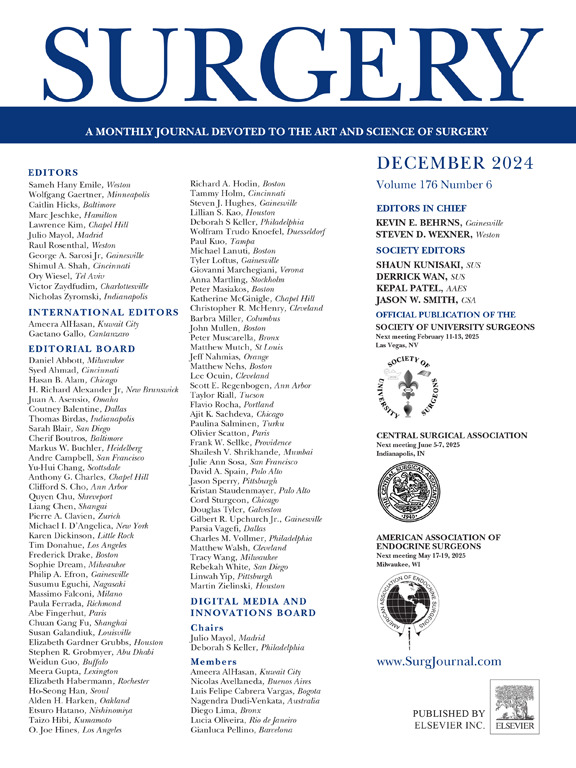Risk assessment of lymph node metastasis in early gastric cancer patients with vagus nerve–preserving gastrectomy: A multiple centers potential analysis in China
IF 3.2
2区 医学
Q1 SURGERY
引用次数: 0
Abstract
Background
Vagus nerve–preserving gastrectomy is gaining popularity for early gastric cancer treatment. This study assesses vagus nerve–preserving gastrectomy's perioperative safety and impact on postoperative quality of life, and explores vagus nerve–associated lymph node metastasis to create a risk model for enhanced therapy.
Methods
Clinicopathologic data from 1,210 early gastric cancer patients across 11 Chinese centers were analyzed, and the data of 800 patients with follow-up information and 48 patients who underwent vagus nerve–preserving gastrectomy for validation were collected. Propensity score matching was applied to the analysis of perioperative safety and quality of life in vagus nerve–preserving gastrectomy patients. A 6-point risk assessment model was devised and validated to evaluate the risk of vagus nerve–associated lymph node metastasis after vagus nerve–preserving gastrectomy in early gastric cancer patients.
Results
Vagus nerve–preserving gastrectomy patients had shorter postoperative stays, quicker drainage cessation, and fewer incidences of diarrhea, acid reflux, and postoperative gallstones. Additionally, key independent risk factors for vagus nerve–associated lymph node metastasis included tumor size, differentiation type, invasion depth, and lymphatic vessel invasion. Using these factors, a 6-point risk assessment model was established. The values of the area under the receiver operating characteristic curve for the model were 0.796, 0.806, 0.808, and 0.829 in the training cohort, internal validation cohort, external validation cohort, and vagus nerve–preserving gastrectomy cohort, respectively. The model effectively differentiated between high- and low-risk groups in terms of postoperative survival.
Conclusions
Vagus nerve–preserving gastrectomy can improve the patients' postoperative quality of life and ensure safety in the perioperative period. The vagus nerve–associated lymph node metastasis risk assessment model is a crucial tool in guiding the selection of optimal surgical procedures and treatment strategies for early gastric cancer patients.
保留迷走神经的胃切除术对早期胃癌患者淋巴结转移的风险评估:中国多中心潜力分析
背景dvagus保神经胃切除术在早期胃癌治疗中越来越受欢迎。本研究评估保留迷走神经的胃切除术围手术期安全性及对术后生活质量的影响,并探讨迷走神经相关淋巴结转移,为强化治疗建立风险模型。方法分析全国11个中心1210例早期胃癌患者的临床病理资料,收集800例随访资料和48例行保留迷走神经胃切除术验证的患者资料。采用倾向评分匹配法对保留迷走神经的胃切除术患者围手术期的安全性和生活质量进行分析。设计并验证了6点风险评估模型,评估早期胃癌患者保留迷走神经的胃切除术后迷走神经相关淋巴结转移的风险。结果保留迷走神经的胃切除术患者术后住院时间短,引流停止速度快,腹泻、胃酸反流和术后胆结石发生率低。此外,迷走神经相关淋巴结转移的关键独立危险因素包括肿瘤大小、分化类型、浸润深度和淋巴管浸润。利用这些因素,建立了6点风险评价模型。在训练组、内部验证组、外部验证组和保留迷走神经的胃切除术组中,模型的受试者工作特征曲线下面积分别为0.796、0.806、0.808和0.829。该模型在术后生存方面有效区分了高危组和低危组。结论保神经胃切除术可提高患者术后生活质量,保证围手术期安全。迷走神经相关淋巴结转移风险评估模型是指导早期胃癌患者选择最佳手术方式和治疗策略的重要工具。
本文章由计算机程序翻译,如有差异,请以英文原文为准。
求助全文
约1分钟内获得全文
求助全文
来源期刊

Surgery
医学-外科
CiteScore
5.40
自引率
5.30%
发文量
687
审稿时长
64 days
期刊介绍:
For 66 years, Surgery has published practical, authoritative information about procedures, clinical advances, and major trends shaping general surgery. Each issue features original scientific contributions and clinical reports. Peer-reviewed articles cover topics in oncology, trauma, gastrointestinal, vascular, and transplantation surgery. The journal also publishes papers from the meetings of its sponsoring societies, the Society of University Surgeons, the Central Surgical Association, and the American Association of Endocrine Surgeons.
 求助内容:
求助内容: 应助结果提醒方式:
应助结果提醒方式:


